Phenotyping Water Deficit Acclimation Responses
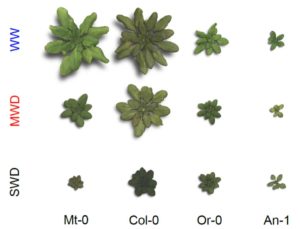 Water deficit (WD) is one of the main environmental stress factors affecting crops and global food security. Acclimation to WD, however, enables plants to maintain growth under unfavorable environmental conditions. To shed light on the molecular mechanisms underlying WD acclimation, Rymaszewski et al. () investigated the natural variation of long-term acclimation to moderate and severe soil WD in 18 Arabidopsis accessions using PHENOPSIS, an automated phenotyping platform. Studies of plant acclimation to WD are labor intensive because they require frequent monitoring and correction of soil water content. Thus, it is essentially impossible to manually perform acclimation experiments on multiple plants at the same time. For plants grown in pots, this problem was solved by the development of plant phenotyping platforms such as PHENOPSIS, which enable automatic maintenance of soil water content and automated measurements of multiple plant traits. Using this technology, the authors investigated the long-term acclimation to constant WD at the morphophysiological and molecular levels in 18 Arabidopsis accessions isolated from different natural habitats. These accessions were chosen for study because they displayed differences in the transcript level of the drought response-related marker ANNEXIN (ANN1) in the absence of stress treatments. Plants were subjected to two severities of constant WD, in addition to well-watered (WW) controls. The authors measured a large subset of plant traits related to plant growth and water use to analyze for WD effects. In parallel, they performed expression analyses of a set of 16 genes related to physiological responses to WD. Contrary to most published studies, the transcript levels were analyzed after a long acclimation period using plant material collected before dawn to minimize the effect of circadian oscillations on transcript levels. As expected, severe WD conditions had a greater effect on most of the measured morphophysiological traits than did moderate WD conditions. The results, however, also revealed that different accessions displayed different types of acclimation responses to long-term WD and that morphophysiological traits, such as rosette area, transpiration rate, and rosette water content, were closely linked to expression levels of certain stress-response genes. The results point to the potential of using gene expression levels as a predictor of morphophysiological WD responses, which would be particularly useful for breeders because it would not be necessary to apply WD during the process of cultivar selection.
Water deficit (WD) is one of the main environmental stress factors affecting crops and global food security. Acclimation to WD, however, enables plants to maintain growth under unfavorable environmental conditions. To shed light on the molecular mechanisms underlying WD acclimation, Rymaszewski et al. () investigated the natural variation of long-term acclimation to moderate and severe soil WD in 18 Arabidopsis accessions using PHENOPSIS, an automated phenotyping platform. Studies of plant acclimation to WD are labor intensive because they require frequent monitoring and correction of soil water content. Thus, it is essentially impossible to manually perform acclimation experiments on multiple plants at the same time. For plants grown in pots, this problem was solved by the development of plant phenotyping platforms such as PHENOPSIS, which enable automatic maintenance of soil water content and automated measurements of multiple plant traits. Using this technology, the authors investigated the long-term acclimation to constant WD at the morphophysiological and molecular levels in 18 Arabidopsis accessions isolated from different natural habitats. These accessions were chosen for study because they displayed differences in the transcript level of the drought response-related marker ANNEXIN (ANN1) in the absence of stress treatments. Plants were subjected to two severities of constant WD, in addition to well-watered (WW) controls. The authors measured a large subset of plant traits related to plant growth and water use to analyze for WD effects. In parallel, they performed expression analyses of a set of 16 genes related to physiological responses to WD. Contrary to most published studies, the transcript levels were analyzed after a long acclimation period using plant material collected before dawn to minimize the effect of circadian oscillations on transcript levels. As expected, severe WD conditions had a greater effect on most of the measured morphophysiological traits than did moderate WD conditions. The results, however, also revealed that different accessions displayed different types of acclimation responses to long-term WD and that morphophysiological traits, such as rosette area, transpiration rate, and rosette water content, were closely linked to expression levels of certain stress-response genes. The results point to the potential of using gene expression levels as a predictor of morphophysiological WD responses, which would be particularly useful for breeders because it would not be necessary to apply WD during the process of cultivar selection.


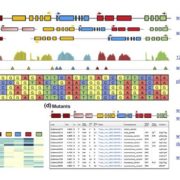
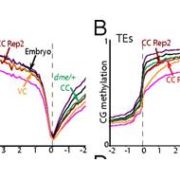
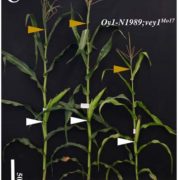
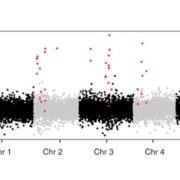




Leave a Reply
Want to join the discussion?Feel free to contribute!